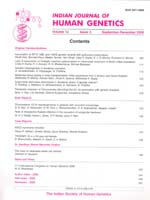
|
Indian Journal of Human Genetics
Medknow Publications on behalf of Indian Society of Human Genetics
ISSN: 0971-6866 EISSN: 1998-362x
Vol. 9, Num. 1, 2003, pp. 29-30
|
Indian Journal of Human Genetics, Vol. 9, No. 1, Jan-Jun, 2003, pp. 29-30
Special Report
Human herpesvirus 6: Catalyst of genomic lesion in dysfunctional
hematopoiesis ?
Atanu Basu
National Institute of Virology (ICMR), 20A Dr. Ambedkar Road,
Pune-411001.
Address for correspondence: Atanu Basu, National Institute of Virology
(ICMR), 20A Dr Ambedkar Road, Pune-411001. Code Number: hg03008
The Human herpesvirus type 6 (HHV6) originally discovered as
a chance isolation from patients with human immunodeficiency virus infections,
remain a virus whose disease causing potential remain incompletely understood.1 Several
major studies provided convincing evidence to link HHV6 with human illness.
These included exanthum subitum, and possibly transient erythroblastopenia
of childhood.2 However, a rather large spectrum of undifferentiated
illness ranging from febrile convulsions to fulminant hepatitis and possibly
multiple scleoris, where suspected etiologic association of HHV6 has been proposed
remain controversial.3
Interestingly, although most of the adult population shows
evidence of antibodies against HHV6, the virus can reactivate and cause severe
disease in immunocompromised hosts, specially transplant cases. The presentation
can range from frank bone marrow failure to hepatitis and even encephalitis.
However it is not clear what host and virus factors create and start this pathophysiologic
event but the possible role of HHV6 in directly infecting human hematopoietic
stem cells has been demonstrated.
Aplastic anemia is a form of bone marrow failure syndrome
first described in 1888 by Paul Ehrlich. Although many aspects of the disease
has been well studied over the years, several important etiologic considerations-specially
the possible role of hematosuppressive viruses-remain incompletely understood.4 Herpesviruses have
been indicated but no conclusive line of evidence has emerged to pinpoint their
role in this disease. Case reports have shown possible infection with Epstein-Barr
Virus (EBV) and
perhaps CMV.5 In a subset of aplastic anemia cases, termed hepatitis
associated aplastic anemia, a viral-hepatitis-like syndrome precedes the onset
of aplastic anemia. No known hepatitis viruses have been isolated or demonstrated
in such cases. The first possible role of HHV6 and CMV came from a recent study
that showed a rather high prevalence of both human cytomegalovirus (CMV) and
HHV6 DNA in the liver tissue of HAA cases, statistically significant when compared
with appropriate controls. In all cases except one, the HHV6 was variant B but
the CMV genotypes did not show predominance of a single subtype- suggesting a
random reactivation
pattern.6 Interestingly, cytokine profiling of such patients showed
high prevalence of interferon g and pro-inflamatory cytokines like IL-10 (unpublished
data) suggesting active infection process. The possible interaction of HHV6 with
other herpesviruses like EBV in myelodysplastic and chronic myeloproliferative
states had been further demonstrated where the viral antigen expression could
be clearly shown in intrephine biopsy material taken from patients suggesting
possible reactivation of these viruses as pathophysiologic factors in hematopoietic
disorders.7 By itself, persistent bone marrow infection with HHV6
may also lead to chronic
myelosupression.8
Interestingly in 1994, sequence analysis of the HHV6 genome
revealed the presence of A(GGGTTA)n motifs identical to the human telomeric
repeat sequence (TRS).9 These findings suggested that TRS elements
may play important and yet incompletely understood role in the biology of HHV6
infection at a cellular level and perhaps more importantly interfere in some
way with
the host genome as was suggested from a recent
study where latency associated nuclear antigens of
HHV8 could transactivate telomerase reverse
transcriptase promoters in Kaposi's
sarcoma.10
In summary, the growing body of evidence for possible genome-interference
role of HHV6 alone or in association with other herpesviruses, provides the
beginning of our understanding towards an unique molecular pathophysiology
of hematological diseases that in combination with environmental factors may
constitute primary etiology of marrow failure syndromes. However, extensive
studies are required to identify and differentiate such factors -both virus
and host.
REFERENCES
- Salahuddin SZ, Ablashi DV, Markham PD, et al. Isolation
of a new virus: HBLV in patients with lymphoproliferative disorders.
Science 1986;234:516
- Yamanishi K, Okuno T, Shiraki K, et al. identification
of human herpesvirus 6 as a causal agent of exanthum subitum. Lancet
1988;1:1065-7.
- Wilborne F, Scmidt CA, Brinkman V, et al. A potential
role of HHV6 in nervous system disease. J
Neurovirol 1994;49:213.
- Young NS. Bone marrow Failure Syndrome. WB Saunders Co;
2000. pp. 1.
- Sullivan JL. Hematologic consequences of Epstein-Barr virus
infection. Hematol Oncol Clin North Am 1987;1:397-417.
- Basu A, Wong S, Neal S, Young KE. Brown (2001) No Association
of Specific genotypes of CMV and HHV6 in hepatic Tissues of Patients
with Hepatitis Associated Aplastic Anemia (HAA) Blood 2001;98:730.
- Krueger GR, Kudlimay D, Ramon A, et al. Demonstration of
active and latent Epstein-Barr virus and human herpesvirus-6 infections
in bone marrow cells of patients with myelodysplasia and chronic myeloprolifertaive
diseases. In vivo 1994;8:533-42.
- Knox KK, Carrigan DR. Chronic myelosuppression associated
with persistent bone marrow infection due to human herpesvirus 6 in
a bone marrow transplant recipient. Clin Infect Dis 1996;22:174-5.
- Thomson BJ, Dewhurst S, Gray D. Structure ad hetongeneity
of the a sequences of human heresvirus 6 strain variants U1102 and
Z 29 and identification of human telomeric repeat sequences at the genomie.
Hermin
J
Virol 1994;68:307-14.
- Knight JS, Cotter MA, Robertson ES. The latency-associated
nuclear antigen of Kaposi's sarcoma associated herpesvirus transactivates
the telomerase reverse transcriptase. J Biol Chem 2001;276:1-8.
Copyright 2003 - the Indian Society of Human Genetics
|
